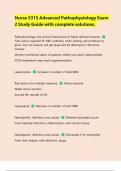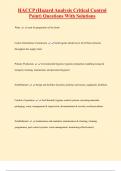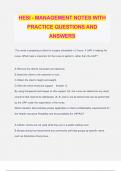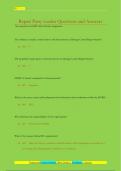Nurse 5315 Advanced Pathophysiology Exam
a- a- a- a- a-
2 Study Guide with complete solutions.
a- a- a- a- a- a-
Pathophysiology and clinical implications of folate deficient anemia
a- a- a- a- a- a- a- a-a- a-
Folic acid is required for RBC synthesis, when lacking, cell continues to
a- a- a- a- a- a- a- a- a- a- a- a-
grow- but not mature, will get large and be destroyed in the bone
a- a- a- a- a- a- a- a- a- a- a- a- a-
marrow a-
Monitor nutritional status of patients, elderly are easily malnourished
a- a- a- a- a- a- a- a-
ETOH dependent may need supplementation
a- a- a- a-
Leukocytosis a-a- a- Increase in number of total WBC a- a- a- a- a-
Risk factors for multiple myeloma
a- a- a- a- a-a- African descent
a- a-
Males more common
a- a-
Around 6th decade of life
a- a- a- a-
Leukopenia a-a- a- Decrease in number of total WBC a- a- a- a- a-
Neutrophilia- definition and causes a- a- a- a-a- a- Elevated neutrophil count a- a-
From bacterial infections, inflammation, and necrotic tissue
a- a- a- a- a- a-
Neutropenia- definition and causes a- a- a- a-a- a- Decreased # of neutrophils a- a- a-
From liver disease, viral infections, drugs
a- a- a- a- a-
,Risk factors and CM of folate deficient anemia
a- a- a- a- a- a- a- a-a- a- Risk: malnourished,
a- a-
alcoholic a-
CM: beefy red tongue, weakness, fatigue, loss of appetite, weight loss
a- a- a- a- a- a- a- a- a- a-
Risk factors and CM of iron deficient anemia
a- a- Risk: PUD, excessive
a- a- a- a- a- a-a- a- a- a- a-
menstruation, occult GI bleed, inadequate dietary intake, Meds with GI
a- a- a- a- a- a- a- a- a- a-
bleed risk a-
CM: fatigue, hypoxia, SOB, pale tissues, glossitis, spoon shaped nails
a- a- a- a- a- a- a- a- a-
Pathophysiology and clinical implications of iron deficient anemia
a- a- a- a- a- a- a- a-a- a-
Microcytic
Iron is necessary for production of hgb. Iron stores are depleted and less
a- a- a- a- a- a- a- a- a- a- a- a- a-
hgb is produced, results in small RBCs
a- a- a- a- a- a-
Most common worldwide, usially from chronic blood loss or pregnancy,
a- a- a- a- a- a- a- a- a- a-
more common in women
a- a- a-
Leukotrines Released when mast cells degranulate, prolong the
a-a- a- a- a- a- a- a- a- a-
inflammatory process. Cause vasodilation, attract neutrophils, monocytes,
a- a- a- a- a- a- a-
and eosinophils.target of inhibition for singular.
a- a- a- a- a-
Prostaglandins Released when mast cells degranulate, are produced
a-a- a- a- a- a- a- a- a- a-
by the arachidonic pathway. Cause vasodilation, platelet aggregation at
a- a- a- a- a- a- a- a- a-
site of injury, pain, and fever.
a- a- a- a- a-
, Chemotactic factors Biochemical substance that attracts leukocyte to
a- a-a- a- a- a- a- a- a- a-
the site of inflammation
a- a- a-
Neutrophils Predominant leukocyte at work during the early stages
a-a- a- a- a- a- a- a- a- a- a-
of acute inflammation
a- a-
Monocytes Become macrophages when entering the tissue,
a-a- a- a- a- a- a- a- a-
responsible for presenting antigens to the CD4 cell which triggers T-cell
a- a- a- a- a- a- a- a- a- a- a-
immunity and B-cell immunity.
a- a- a-
Releases additional cytokines IL1, IL6, TNF.
a- a- a- a- a-
Cytokine IL1 function
a- Causes fever, activates phagocytes &
a- a-a- a- a- a- a- a- a-
lymphocytes and also increases the release of IL6a
a- a- a- a- a- a- a-
Cytokine IL6 function
a- Stimulates production of acute phase reactants
a- a-a- a- a- a- a- a- a- a-
and promotes growth and stimulation of RBCs
a- a- a- a- a- a-
Cytokine TNF function
a- Causes fever, increases synthesis of
a- a-a- a- a- a- a- a- a-
proinflammatory proteins by liver, causes muscle wasting, induces
a- a- a- a- a- a- a- a-
thrombosis
Cytokine growth factor function
a- a- a- a-a- Promotes production and
a- a- a- a-
maturation of neutrophils a- a-







